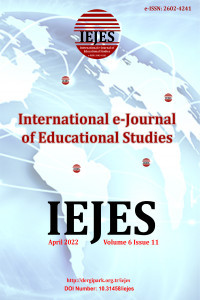Development of Turkish Reading Anxiety Scale
Second language acquisition, reading anxiety, bilingualism, language development
Development of Turkish Reading Anxiety Scale
___
- Aydın,S., & Zengin, B. (2008). Yabancı dil öğreniminde kaygı: Bir literatür özeti [Anxiety is foreign language learning: A literature reiw]. Journal of Language and Linguistic Studies, 4(1), 81-94.
- Bailey, P., Onwuegbuzie, A., & Daley, C. E. (2000). The impact of socio-affective variables on African American and hispanic American language learners’ achievement. Foreign Language Annals, 33(4), 357-372.
- Büyüköztürk, S. (2017). Manual of data analysis for social sciences. Ankara: Pegem Academy
- Byrne, UN (2010). Structural equation modeling with AMOS: Basic concepts, applications and programming. NY: Taylor and Francis Group.
- Cattell, R. B. (1978). The scientific use of factor analysis in behavioral and life sciences. NY: Plenum.
- Cohen J. (1988). Statistical power analysis for the behavioral Sciences, 2nd ed. New Jersey: Erlbaum.
- Erkuş, A. (2012). Measurement and scale development in psychology. Ankara: Pegem Academy
- Floyd, F. J., & Widaman, K. F. (1995). Factor analysis in the development and refinement of clinical assessment instruments. Psychological Assessment, 7 (3), 286-1999.
- Fraenkel, J. R., Wallen, N. E., & Hyun, H. H. (2012). How to design and evaluate research in education (Edisi Kedelapan ed.). (S. Kiefer, Penyunt.) NY: McGraw-Hill Companies.
- Gorsuch, R. L. (1983). Factor analysis (2nd ed.). NJ: Lawrence Erlbaum.
- Henson, R., & K., Roberts, J., K. (2006). Use of exploratory factor analysis in published research: Common errors and some comment on improved practice. Educational and Psychological Measurement, 66 (3), 393-416.
- Horwitz, E. K., Horwitz, M. B., & Cope, J. (1986). Foreign language classroom anxiety. The Modern Language Journal, 70(2), 125-132.
- İlhan, M., & Çetin, B. (2014). Developing the classroom assessment atmosphere scale (SCAS): A study of validity and reliability. Education and Science, 39 (176), 31-50.
- Joreskog, K. G., & Sorbom, D. A. (2006). LISREL 8.54 and PRELIS 2.54. IL: Scientific Software.
- Kasap, S. & Power, K. M. (2019). Anxiety in the EFL speaking classrooms. The Journal of Language Teaching and Learning, 9(2), 23-36.
- Kasap, S. (2021). Impact of bilingualism and the difficulties of having minority-specific names in another dominant society: Turkish context for minority Kurdish society. Journal of the International Council of Onomastic Sciences 56, 167–186. https://doi.org/10.34158/onoma.56/2021/9
- Kasap, S. (2021). Mother tongue attitude scale (MTAS). International Journal of Kurdish Studies 7 (1), 103-122, https://doi.org/10.21600/ijoks.834913
- Kline, R. B. (2011). Principles and practice of structural equation modeling. NY: The Guilford Press.
- Liu, M. & Jackson J. (2008). An exploration of Chinese EFL learners’ unwillingness to communicate and foreign language anxiety. The Modern Language Journal, 92(1), 71- 86.
- Liu, Y. (2003). Developing a scale to measure the interactivity of websites. Journal of Advertising Research, 43(2), 207-216.
- Lucke, J. F. (2005). The α and ω of congeneric test theory: An extension of reliability and internal consistency to heterogeneous tests. Applied Psychological Measurements, 29 (1), 65-81.
- MacIntyre, P. D., & Gardner, R. C. (1989). Anxiety and second-language learning: Toward a theoretical clarification. Language Learning, 39(2), 251-275.
- Schermelleh-Engel, K., Moosbrugger, H., & Müller, H. (2003). Evaluating the fit of structural equation models: Test of significance and descriptive goodness -of-fit measures. Methods of Psychological Research -Online, 8(2), 23-74.
- Stevens, J. (2002). Applied multivariate statistics for the social Sciences (4th Edition). Mahwah, NJ: Lawrence Erlbaum Associates.
- Tabachnick, B. G., & Fidel, L. S. (2007). Using multivariate statistics (5th ed.). NY: Ally and Bacon.
- Young, D. J. (1991). Creating a low-anxiety classroom environment: What does language anxiety research suggest? The Modern Language Journal, 75(4), 426-439.
- Yurdugül, H. (2005). Using content validity indexes for content validity in scale development studies. XIV. National Educational Sciences Congress, 1, 771-774.
- Başlangıç: 2017
- Yayıncı: Tamer KUTLUCA
Sustainability and its Reflection on Education
Development of Turkish Reading Anxiety Scale
Suleyman KASAP, Mahmut AYAZ, Mehmet Sena ATAŞ
Distance Education Competencies of Physical Education Teachers: Elazığ Province
Oğuzhan ALTUNGÜL, Didem YAVUZ SÖYLER
Seventh-Grade Students’ Perspective on Non-Governmental Organization
An Analysis of the Place of the History of Science in Chemistry Textbooks
Gülşah ZERMAN KEPCEOĞLU, Serhat İREZ
Peer Bullying Experiences and Management Strategies of Preschool Teachers
An Ontological Study on Proof: If and only If Propositions
Video-Based IBL and Conventional Approaches to Critical Thinking Skills in Terms of Gender
Mayarni MAYARNİ, Fasli JALAL, Mohamad Syarif SUMANTRİ, Wardani RAHAYU
